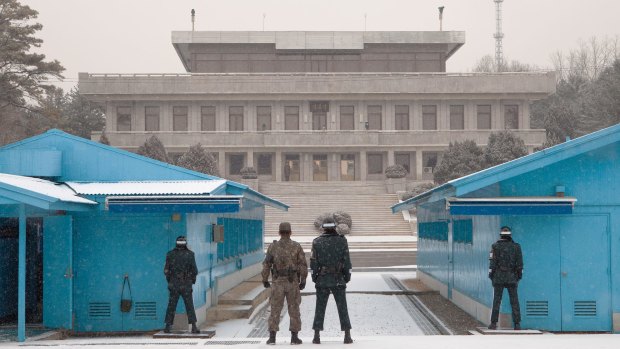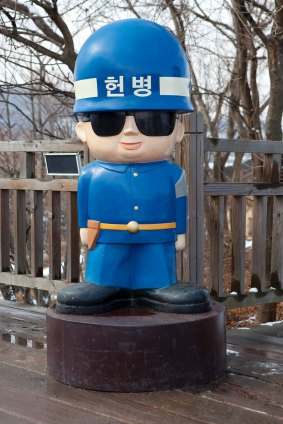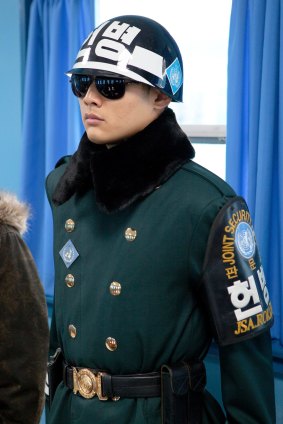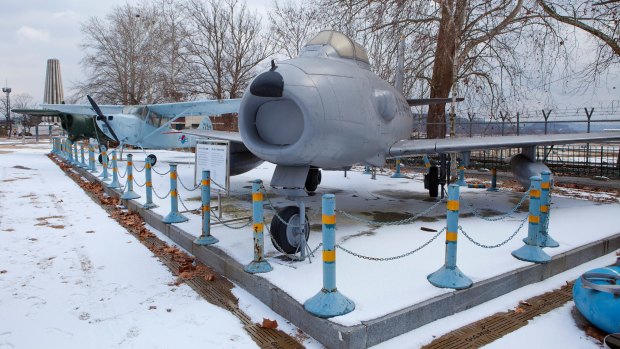This was published 6 years ago
Visiting the Demilitarised Zone on the border of North and South Korea: Touring the DMZ
By Mark Daffey
During the month before our coach tour from Seoul to the Demilitarised Zone (DMZ) separating North and South Korea, the North conducted underground nuclear weapons testing and fired a new long-range missile. In retaliation, South Korea closed its factory complex just over the border at the Kaesong Industrial Complex, an uneasy alliance combining South Korea's technical knowledge and capital with cheap labour from the North, where monthly wages average $US200 against $US4000 in the South.
Winter snowflakes drift down outside our windows as we pass through the Civilian Control Line, 50 kilometres north of Seoul and the first checkpoint along Highway 1, the only road connecting the two Koreas. From this point north, 10 kilometres from the Military Demarcation Line (MDL) border that separates the two foes, civilian habitation is confined to just two small farming communities.
A South Korean soldier boards our bus to check our passports and dress code (no ripped jeans, sandals or clothing displaying provocative text) before we board a military bus at Camp Bonifas, the army base just outside the DMZ, a heavily fortified, 240-kilometre-long buffer zone either side of the border. Our guide, Seon Mee, advises us to leave any bags on the bus. "Cameras and phones must be carried in your hands," she says.

Soldiers stand guard at the Joint Security Areabetween North and South Korea. The JSA was created in 1953 as a neutral area inside the Demilitarised Zone (DMZ) for negotiating peace agreements between North and South Korea.Credit: Mark Daffey
Because of the snow, a decision is made to postpone our briefing on behavioural protocol inside the Joint Security Area (JSA) until after we've passed through a double barbed-wire fence and entered Freedom House, a Soviet-style concrete "palace" overlooking the border. It was here that the two sides traded shots after the defection of a Russian asylum seeker in 1984. And as recently as November 13, 2017, a North Korean soldier made a bold dash across the MDL under a hail of gunfire.
Considering this border region's chequered history, it surprises no one when we're asked to sign waiver forms against the "possibility of injury or death as a direct result of enemy action". We are also under strict instructions not to point at anyone, and at one stage I kneel on one knee to take a photograph whereupon I'm promptly ordered to stand up again, lest it be considered inflammatory. To say that this place is jittery is beyond doubt.
A total of 24 buildings, often referred to as Truce Village, are scattered around inside the JSA, where South Korea's Freedom House mirrors a North Korean equivalent, Panmun Hall. In between are two white barracks, which flank three buildings painted in the powder blue colour of the United Nations. Collectively, they are known as Conference Row, as this is where officials from both sides meet to discuss diplomatic issues under the watchful eye of the UN. Office desks are scattered around a room that's otherwise remarkable for its austerity, with the MDL that roughly follows the 38th Parallel cutting through the middle of them.

A dummy soldier beside the Bridge of Freedom at Imjingak Park, South Korea.Credit: Mark Daffey
This part of the JSA – also known as Panmunjeom, after the village here that was abandoned during the war – is as close as you're likely to get to a North Korean soldier. Outside, I count seven South Korean guards, plus a further three UN soldiers. Two South Korean soldiers stand to attention inside the middle building. Just one North Korean soldier is visible across the border.
From the JSA, we cross back over the Imjin River to Imjingak Park, where an amusement centre incongruously appears beside military hardware and monuments to fallen soldiers. Other significant exhibits are a bullet-riddled steam locomotive and the timber Bridge of Freedom, where 13,000 prisoners of war traded sides after the signing of the 1953 Armistice Agreement to halt the Korean War.
Four North Korean border tunnels were discovered between 1974 and 1990. The third tunnel was unearthed in 1978 and it is into this that we descend next, boarding a monorail then walking through a two-metre-diameter burrow that would have allowed up to 3000 North Korean troops to infiltrate enemy lines each hour had it not been found. At 1635 metres, it is the longest of the four tunnels, and the closest to Seoul.

A South Korean soldier stands guard in a Joint Security Area conference room.Credit: Mark Daffey
The tunnel is just east of Dorasan Station, the last stop on the Gyeonggi railway line that extended into North Korea in the hope that it would grow into a global distribution hub for the Far East. Opened in 2007, the line continued through to Kaesong then closed a year later after North Korea's fledgling nuclear weapons program became an open secret. The station represents little more than an outsized monument to hope now. Dora Observatory, the lookout point into the North Korean side of the DMZ and perhaps as far as Kaesong, would normally be the final stop on our tour. But the poor weather foils our plans and instead we return – safely – to Seoul.
Mark Daffey travelled as a guest of the Korean Tourism Organisation.
Trip Notes

Vintage military hardware on display in Imjingak Park, South Korea.Credit: Mark Daffey
MORE
FLY
Korean Air flies daily from Sydney to Seoul/Incheon, and flies direct from Brisbane four times a week, with daily flights during the peak season of December to February. See koreanair.com
TOUR
Joongang Express Tour's full-day Panmunjeom/JSA itineraries from Seoul cost about $100. See jsatour.com
See also: South Korea - Asia's overlooked destination is about to boom
Sign up for the Traveller Deals newsletter
Get exclusive travel deals delivered straight to your inbox. Sign up now.